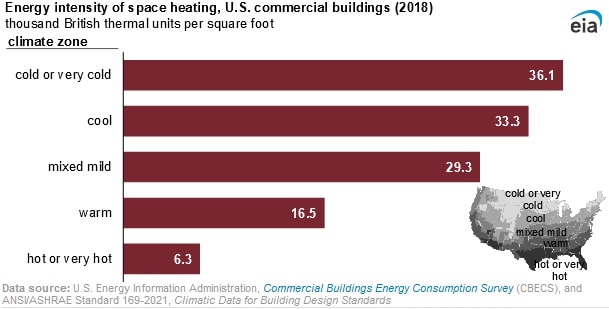Heating U.S. Commercial Buildings Over Five Times More Energy Intensive in Cold Climates: EIA

U.S. Commercial structures in cold temperatures were over five times more energy intensive than hot climates for space heating, according to an Sept. 6 report from the U.S. Energy Information Administration. The agency determines space heating energy intensity projections for each building category by dividing total usage of key energy fuels, such as electricity, fuel oil and natural gas for space heating by the overall floorspace of the structure that uses one of those fuels for heating in each climate zone.
The recently published 2018 Commercial Buildings Energy Consumption Survey reported that commercial buildings in cold climates used an average of 36,100 British thermal units per square foot, but buildings in hot climates utilized an average of 6,300 British thermal units per square foot.
Commercial structures in cooler climate zones were likely to be heated more often and have a larger portion of their floorspace allocated to be heated. In cold climate zones, 62 percent of structures reported heating of all their effective area, but in hot climate zones, 40 percent of structures reported heating all of their space requirements.
In terms of fuel in the generation mix, natural gas was the major energy source utilized for heating in U.S. commercial structures, accounting for 73 percent of the 2,167 trillion British thermal units of key fuels used for heating in 2018. District heat accounted for 12 percent of the energy source required to fulfil U.S. commercial space heating demand, followed closely by electricity which accounted for 11 percent. Fuel oil provided four percent of U.S. commercial space heating energy usage and another 11 percent was from sources that are excluded in major fuels consumption, such as propane and wood.
With regards to climate zones and energy sources, the agency reports that mixed mild climate zones have the smallest share of natural gas utilized for space heating and the largest proportion of district heating utilization for heating. In contrast, the hottest climate zones had the largest proportion of electricity utilization for heating and the coldest climate zone had fuel oil as the largest share of energy source utilized for heating.
EnerKnol Pulses like this one are powered by the EnerKnol Platform—the first comprehensive database for real-time energy policy tracking. Sign up for a free trial below for access to key regulatory data and deep industry insights across the energy spectrum.
ACCESS FREE TRIAL